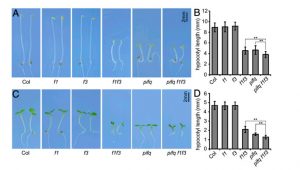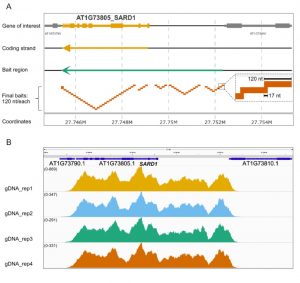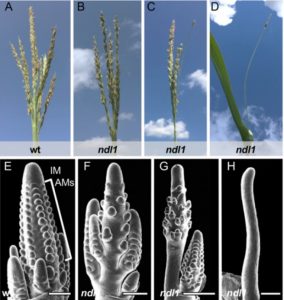Plant Science Research Weekly: October 4th
Letter. The human health benefits from GM crops
 If you’ve ever spoken publicly about GM crops, you’ve probably heard people express concern about how eating GM crops might affect their health. Smyth lays out a positive case for the human health benefits of GM crops, which will be a useful resource for science communicators. Here he focuses on the benefits to the smallholder farmers mainly in developing countries whose exposure to pesticides has been greatly diminished by adopting Bt-expressing crops, particularly cotton and brinjal (eggplant). He also points to the adoption of GM crops as contributing to improved yields and profit, helping to reduce the incidence of farmer stress and suicides, and decreasing consumer exposure to cancer-causing mycotoxins. Greater economic security for farmers also means better nutrition for them and their families. Ultimately, nutrient-enhanced crops will be available for additional benefits. This letter raises the important point that choosing to avoid GM crops is fine for the wealthy, but access to them has real benefits to the world’s poor. (Summary by Mary Williams) Plant Biotech. J. 10.1111/pbi.13261. Image by Bishnu Sarangi from Pixabay
If you’ve ever spoken publicly about GM crops, you’ve probably heard people express concern about how eating GM crops might affect their health. Smyth lays out a positive case for the human health benefits of GM crops, which will be a useful resource for science communicators. Here he focuses on the benefits to the smallholder farmers mainly in developing countries whose exposure to pesticides has been greatly diminished by adopting Bt-expressing crops, particularly cotton and brinjal (eggplant). He also points to the adoption of GM crops as contributing to improved yields and profit, helping to reduce the incidence of farmer stress and suicides, and decreasing consumer exposure to cancer-causing mycotoxins. Greater economic security for farmers also means better nutrition for them and their families. Ultimately, nutrient-enhanced crops will be available for additional benefits. This letter raises the important point that choosing to avoid GM crops is fine for the wealthy, but access to them has real benefits to the world’s poor. (Summary by Mary Williams) Plant Biotech. J. 10.1111/pbi.13261. Image by Bishnu Sarangi from Pixabay
VP1 regulates intra-kernel protein reallocation
 Maize kernels have a triploid endosperm and a diploid embryo. Storage reserves move from the endosperm to the embryo as it grows. Mutants have been identified with abnormal embryos but normal endosperms, although usually a defective endosperm prevents normal embryo formation. Here Zheng and Li et al. investigated how disrupting the accumulation of zein proteins in the endosperm (through RNA interference) affects embryo development. In these plants, the embryo produces more globlulin, another type of storage protein. Transcriptomic analysis showed that many of the genes affected by zein gene silencing are regulated by transcription factor VIVIPAROUS-1 (VP1), so named because loss-of-function of VP1 leads to premature seed germination (vivipary means live birth). In vp1 mutants, nutrient assimilation in the embryo is also abnormal. This study shows a key role for VP1 in signalling and nutrient transfer between the endosperm and embryo. (Summary by Mary Williams) Plant Cell 10.1105/tpc.19.00444.
Maize kernels have a triploid endosperm and a diploid embryo. Storage reserves move from the endosperm to the embryo as it grows. Mutants have been identified with abnormal embryos but normal endosperms, although usually a defective endosperm prevents normal embryo formation. Here Zheng and Li et al. investigated how disrupting the accumulation of zein proteins in the endosperm (through RNA interference) affects embryo development. In these plants, the embryo produces more globlulin, another type of storage protein. Transcriptomic analysis showed that many of the genes affected by zein gene silencing are regulated by transcription factor VIVIPAROUS-1 (VP1), so named because loss-of-function of VP1 leads to premature seed germination (vivipary means live birth). In vp1 mutants, nutrient assimilation in the embryo is also abnormal. This study shows a key role for VP1 in signalling and nutrient transfer between the endosperm and embryo. (Summary by Mary Williams) Plant Cell 10.1105/tpc.19.00444.
Arabidopsis PP6 phosphatases dephosphorylate PIF proteins to repress photomorphogenesis
 In the absence of light, plants undergo skotomorphogenesis, characterized by longer hypocotyls, closed and yellowish cotyledons, and apical hooks. in the presence of light, they undergo photomorphogenesis, with inhibited hypocotyl elongation, and open and expanded green cotyledons. Light also modulates directional growth, shade avoidance, and photoperiodic flowering. One of the most important photoreceptors that perceives and responds to the red and far-red light spectrum is the phytochrome family and some of the pivotal interacting partners are PHYTOCHROME INTERACTING FACTORs (PIFs), which repress photomorphogenesis in the dark. Thair stability is controlled by phosphorylation. Although the kinases responsible for PIF phosphorylation have been extensively described, the phosphatases remain unknown. Yu et al. characterized the function of two genes encoding conserved catalytic subunits of protein phosphatase 6 (PP6). PP6 phosphatases and PIFs function synergistically to repress photomorphogenesis in the dark, moreover the transcriptional regulatory activities of PIFs are dependent on PP6. The data show that PP6 functions as the phosphatase that dephosphorylates PIF3 and PIF4 and regulates photomorphogenesis in Arabidopsis, providing new insights into the light signaling network. (Summarized by Francesca Resentini) PNAS 10.1073/pnas.1907540116
In the absence of light, plants undergo skotomorphogenesis, characterized by longer hypocotyls, closed and yellowish cotyledons, and apical hooks. in the presence of light, they undergo photomorphogenesis, with inhibited hypocotyl elongation, and open and expanded green cotyledons. Light also modulates directional growth, shade avoidance, and photoperiodic flowering. One of the most important photoreceptors that perceives and responds to the red and far-red light spectrum is the phytochrome family and some of the pivotal interacting partners are PHYTOCHROME INTERACTING FACTORs (PIFs), which repress photomorphogenesis in the dark. Thair stability is controlled by phosphorylation. Although the kinases responsible for PIF phosphorylation have been extensively described, the phosphatases remain unknown. Yu et al. characterized the function of two genes encoding conserved catalytic subunits of protein phosphatase 6 (PP6). PP6 phosphatases and PIFs function synergistically to repress photomorphogenesis in the dark, moreover the transcriptional regulatory activities of PIFs are dependent on PP6. The data show that PP6 functions as the phosphatase that dephosphorylates PIF3 and PIF4 and regulates photomorphogenesis in Arabidopsis, providing new insights into the light signaling network. (Summarized by Francesca Resentini) PNAS 10.1073/pnas.1907540116
An inducible genome editing system for plants
 Multiple approaches like T-DNA insertion and small RNA- and CRISPR-Cas9 mediated gene silencing/knockdown are used to alter the expression of specific genes. This allows researchers to understand gene function during plant development or under any physiological condition. The most challenging task in these approaches is achieving tissue-specific knockdown of gene expression. In this paper, Wang et al. have developed an expression-inducible CRISPR/Cas9 construct that allows gene editing in a tissue and growth stage-specific manner. Successful editing of the PLT (PLETHORA) gene in the apical meristem was achieved using an inducible Cas9 construct and a tissue-specific promoter like WOX5 or SCR to express the guide RNAs. Thus the inducible genome editing system can be used to edit genes at the desired spatiotemporal growth stage of plants. (Summary by Suresh Damodaran) bioRxiv 10.1101/779140
Multiple approaches like T-DNA insertion and small RNA- and CRISPR-Cas9 mediated gene silencing/knockdown are used to alter the expression of specific genes. This allows researchers to understand gene function during plant development or under any physiological condition. The most challenging task in these approaches is achieving tissue-specific knockdown of gene expression. In this paper, Wang et al. have developed an expression-inducible CRISPR/Cas9 construct that allows gene editing in a tissue and growth stage-specific manner. Successful editing of the PLT (PLETHORA) gene in the apical meristem was achieved using an inducible Cas9 construct and a tissue-specific promoter like WOX5 or SCR to express the guide RNAs. Thus the inducible genome editing system can be used to edit genes at the desired spatiotemporal growth stage of plants. (Summary by Suresh Damodaran) bioRxiv 10.1101/779140
NODULE INCEPTION recruits the lateral root developmental program for symbiotic nodule organogenesis in Medicago truncatula ($)
 Lateral roots are secondary root organs arising through the dedifferentiation of inner cell layers in the primary root. Nodules arise through symbiosis with rhizobia bacteria in a certain clade of land plants and they also arise through dedifferentiation. Both lateral roots and nodules are part of the plant root system architecture and aid in nutrient uptake from the rhizosphere. There are some similarities and differences in the morphology and developmental molecular signals between the two organs. In this paper Schiessl et al. have identified the cytokinin-auxin signaling events that contribute to primordia development in roots and also the similarity in cytokinin-induced auxin biosynthesis during the organ development. Auxin accumulation occurs at pre-marked sites in the primary root for lateral root development, and nodule development occurs through flavonoid-mediated auxin transport inhibition. LBD16 (LOB-DOMAIN PROTEIN 16) promotes the expression of auxin biosynthesis genes upon induction by cytokinin treatment during nodule development, and LBD16 overexpression leads to increased lateral root production, suggesting that LBD16 could act as a point of convergence for development of both organs. Also, there is a 75% overlap in gene expression between the two lateral organs indicating that nodule development is likely to share some molecular pathways with lateral roots. (Summary by Suresh Damodaran) Curr. Biol. 10.1016/j.cub.2019.09.005
Lateral roots are secondary root organs arising through the dedifferentiation of inner cell layers in the primary root. Nodules arise through symbiosis with rhizobia bacteria in a certain clade of land plants and they also arise through dedifferentiation. Both lateral roots and nodules are part of the plant root system architecture and aid in nutrient uptake from the rhizosphere. There are some similarities and differences in the morphology and developmental molecular signals between the two organs. In this paper Schiessl et al. have identified the cytokinin-auxin signaling events that contribute to primordia development in roots and also the similarity in cytokinin-induced auxin biosynthesis during the organ development. Auxin accumulation occurs at pre-marked sites in the primary root for lateral root development, and nodule development occurs through flavonoid-mediated auxin transport inhibition. LBD16 (LOB-DOMAIN PROTEIN 16) promotes the expression of auxin biosynthesis genes upon induction by cytokinin treatment during nodule development, and LBD16 overexpression leads to increased lateral root production, suggesting that LBD16 could act as a point of convergence for development of both organs. Also, there is a 75% overlap in gene expression between the two lateral organs indicating that nodule development is likely to share some molecular pathways with lateral roots. (Summary by Suresh Damodaran) Curr. Biol. 10.1016/j.cub.2019.09.005
Identification of the Arabidopsis calmodulin-dependent NAD+ kinase that sustains the elicitor-induced oxidative burst
 When pathogens attack, one line of defense is the production of a burst of reactive oxygen species (ROS) which triggers additional defences. ROS is produced by the action of NADPH oxidases, which require NADPH as a substrate; NADPH is derived from NADP+, but where does this come from? Previous studies have pointed to its production involving a (CaM)/Ca2+- dependent NAD+ kinase, but the responsible protein hasn’t been identified. Now, through proteomic and molecular approaches, Dell’Aglio et al. have identified NAD kinase-CaM dependent (NADKc). NADKc is associated with the periphery of the mitochondria, activated in response to elicitor treatment, and contributes to the pool of NADP+ required for ROS production. Genes encoding this protein are found in most but not all photosynthetic organisms. (Summary by Mary Williams) Plant Physiol. 10.1104/pp.19.00912
When pathogens attack, one line of defense is the production of a burst of reactive oxygen species (ROS) which triggers additional defences. ROS is produced by the action of NADPH oxidases, which require NADPH as a substrate; NADPH is derived from NADP+, but where does this come from? Previous studies have pointed to its production involving a (CaM)/Ca2+- dependent NAD+ kinase, but the responsible protein hasn’t been identified. Now, through proteomic and molecular approaches, Dell’Aglio et al. have identified NAD kinase-CaM dependent (NADKc). NADKc is associated with the periphery of the mitochondria, activated in response to elicitor treatment, and contributes to the pool of NADP+ required for ROS production. Genes encoding this protein are found in most but not all photosynthetic organisms. (Summary by Mary Williams) Plant Physiol. 10.1104/pp.19.00912
High-resolution expression profiling of selected gene sets during plant immune activation
 The problem with gene expression profiling is that it preferentially reports on the more highly-expressed genes. Capture sequencing uses targeted sequence libraries to pull out transcripts from genes of interest, including lowly expressed genes, so that their signals aren’t overwhelmed. To explore gene expression early in plant defense responses, Ding, Ngou et al. describe the production of a biotinylated single-strand RNA bait library targeted to to a subset of defense genes in order to better quantify their expression levels. The authors validated their protocol using a wide variety of mutants and mock treatments, demonstrating its specificity and selectivity. (Summary by Mary Williams) bioRxiv 10.1101/775973
The problem with gene expression profiling is that it preferentially reports on the more highly-expressed genes. Capture sequencing uses targeted sequence libraries to pull out transcripts from genes of interest, including lowly expressed genes, so that their signals aren’t overwhelmed. To explore gene expression early in plant defense responses, Ding, Ngou et al. describe the production of a biotinylated single-strand RNA bait library targeted to to a subset of defense genes in order to better quantify their expression levels. The authors validated their protocol using a wide variety of mutants and mock treatments, demonstrating its specificity and selectivity. (Summary by Mary Williams) bioRxiv 10.1101/775973
Ray parenchymal cells contribute to lignification of tracheids in developing xylem of Norway spruce
 Lignin makes up to 27% of the dry weight of wood and is important structurally as well as serving as an effective carbon sink. Lignin is produced from monolignol precursors that are released into the apoplast and then polymerized. Previous studies have suggested that the monolignols are produced not only from the developing conducting cells (tracheids and tracheary elements) but also from adjoining cells, in what has been dubbed the “good neighbour” hypothesis. Blokhina, Laitinen, and Hatakeyamac et al. used single-cell metabolomics and transcriptomics to investigate whether ray parenchymal cells (which don’t lignify) contribute to the monolignol pool. They found that most of the monolignol biosynthesis pathway genes, as well as genes encoding transcription factors that regulate this pathway and those encoding peroxidases and laccases necessary for lignin polymerization, were expressed equally highly in ray cells as tracheids. Thus, their results support the role of ray cells as “good neighbours”. The authors also identified a set of genes expressed expressed solely in ray cells. (Summary by Mary Williams) Plant Physiol. 10.1104/pp.19.00743
Lignin makes up to 27% of the dry weight of wood and is important structurally as well as serving as an effective carbon sink. Lignin is produced from monolignol precursors that are released into the apoplast and then polymerized. Previous studies have suggested that the monolignols are produced not only from the developing conducting cells (tracheids and tracheary elements) but also from adjoining cells, in what has been dubbed the “good neighbour” hypothesis. Blokhina, Laitinen, and Hatakeyamac et al. used single-cell metabolomics and transcriptomics to investigate whether ray parenchymal cells (which don’t lignify) contribute to the monolignol pool. They found that most of the monolignol biosynthesis pathway genes, as well as genes encoding transcription factors that regulate this pathway and those encoding peroxidases and laccases necessary for lignin polymerization, were expressed equally highly in ray cells as tracheids. Thus, their results support the role of ray cells as “good neighbours”. The authors also identified a set of genes expressed expressed solely in ray cells. (Summary by Mary Williams) Plant Physiol. 10.1104/pp.19.00743
NEEDLE1 encodes a mitochondria localized ATP-dependent metalloprotease required for thermotolerant maize growth ($)
 Previously, the needle1 (ndl1) maize mutant was identified as showing a variable phenotype mainly affecting the tassel. Here, Liu et al. showed that this variability arises due to its temperature sensitivity, with strongest effects at warmer temperatures. In some cases, the plants arrest before reaching maturity, and in others the tassel forms a bare, unbranched infertile structure; the authors also identified root defects at elevated temperatures. The tassel phenotype resembles that of auxin mutants, and they showed that ndl1 mutants have altered auxin responses. The authors identified a single nucleotide change in a nuclear gene encoding a mitochondrial-localized ATP-dependent metalloprotease belonging to the FILAMENTATION TEMPERATURESENSITIVE H (FTSH) family. The mutant allele itself is not a temperature sensitive allele; rather, loss-of-function of this gene causes thermal sensitivity. The mutants show high levels of ROS accumulation, leading to altered auxin responses through an unknown mechanism. The authors propose “that NDL1 is required for maintaining the redox status of meristems to sustain maize growth at high temperatures.” (Summary by Mary Williams) Proc. Natl. Acad. Sci. USA 10.1073/pnas.1907071116
Previously, the needle1 (ndl1) maize mutant was identified as showing a variable phenotype mainly affecting the tassel. Here, Liu et al. showed that this variability arises due to its temperature sensitivity, with strongest effects at warmer temperatures. In some cases, the plants arrest before reaching maturity, and in others the tassel forms a bare, unbranched infertile structure; the authors also identified root defects at elevated temperatures. The tassel phenotype resembles that of auxin mutants, and they showed that ndl1 mutants have altered auxin responses. The authors identified a single nucleotide change in a nuclear gene encoding a mitochondrial-localized ATP-dependent metalloprotease belonging to the FILAMENTATION TEMPERATURESENSITIVE H (FTSH) family. The mutant allele itself is not a temperature sensitive allele; rather, loss-of-function of this gene causes thermal sensitivity. The mutants show high levels of ROS accumulation, leading to altered auxin responses through an unknown mechanism. The authors propose “that NDL1 is required for maintaining the redox status of meristems to sustain maize growth at high temperatures.” (Summary by Mary Williams) Proc. Natl. Acad. Sci. USA 10.1073/pnas.1907071116



